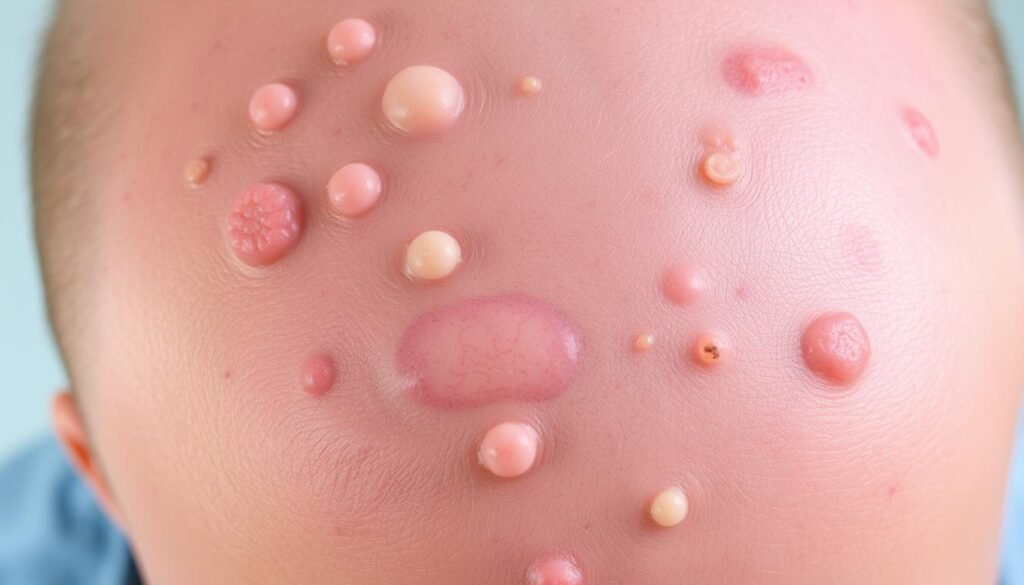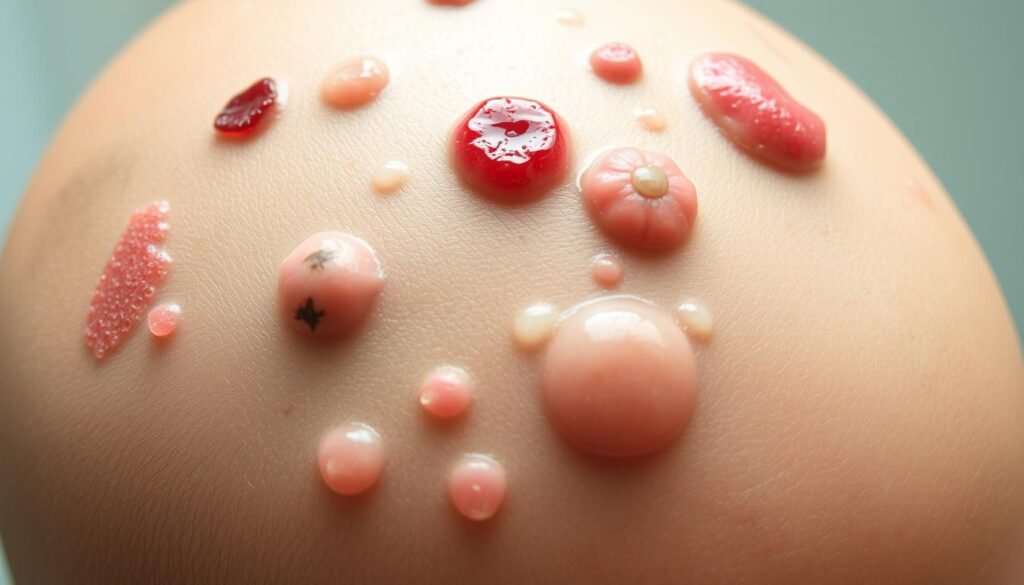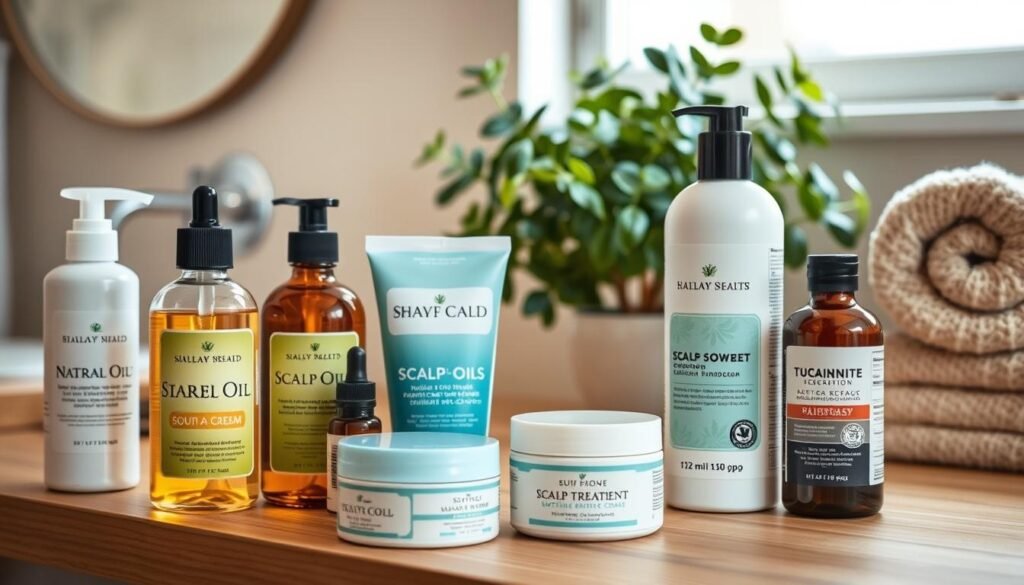About 13 percent of all deadly skin cancers appear on the scalp. This shows how vital it is to understand and spot bumps on our heads. Even though many of these bumps are not harmful, some can be serious, like skin cancer. In this piece, we’ll look at what causes these bumps, how to treat them, and how to prevent them. We’ll cover scalp lesions, cysts, and rashes. With this knowledge, you can take better care of your scalp. You’ll also learn when it’s time to seek more help.
Key Takeaways
- Awareness of scalp bumps is crucial, as some may signal serious conditions like skin cancer.
- Pilar cysts, while harmless, can be cosmetically treated if desired.
- Scalp psoriasis requires special care and can benefit from specific shampoos and prescription medications.
- Proper scalp hygiene is key in preventing conditions like acne and folliculitis.
- Most bumps on the scalp are not serious and may resolve on their own.
- Early diagnosis significantly impacts the treatment outcomes for skin cancer.
- Children are more susceptible to scalp ringworm, although adults can also be affected.
Understanding Bumps on the Scalp
Bumps on the scalp come in different sizes, shapes, and feels. They are often caused by various scalp conditions. These conditions can change how the scalp looks and feels. Signs include itching, redness, and swelling. Knowing the types of bumps is crucial since they might indicate deeper issues like infections, allergies, or blocked hair follicles.
Scalp bumps are common. For instance, dandruff affects nearly half of people worldwide. This shows how widespread scalp issues are. Moreover, about 3% suffer from scalp psoriasis. Such conditions can lead to discomfort and might need treatment.
Many factors lead to bumps forming. Folliculitis, a skin infection, appears as tiny, pimple-like bumps. Eczema can cause rashes and persistent itching, not only on the scalp but also on the body. Quick diagnosis and treatment are crucial for fungal infections, like ringworm of the scalp, to avoid more problems.
Non-infectious conditions like pilar cysts can also cause bumps. These cysts form in blocked hair follicles but are usually safe. Knowing about different scalp bumps helps people recognize symptoms sooner and get the right treatment. This knowledge is key to better managing these conditions.
| Type of Bump | Description | Common Causes |
|---|---|---|
| Folliculitis | Raised red bumps on the scalp | Bacterial infection, ingrown hairs |
| Pilar Cysts | Non-cancerous growths in hair follicles | Clogged hair follicles |
| Dandruff | Flaky skin on the scalp | Dry skin, seborrheic dermatitis |
| Scalp Psoriasis | Red patches covered with silvery scales | Immune system, genetics |
| Shingles | Red, painful blisters on the scalp | Viral infection (varicella zoster virus) |
Common Symptoms of Scalp Bumps
Individuals with bumps on their scalp might notice various scalp symptoms. These include itchy, small bumps and large scaly patches that cause discomfort. Bumps that ooze or produce pus point to folliculitis, suggesting a bacterial infection may be present. Spotting an itchy scalp with redness is key to figuring out the problem.
People may also see red bumps on the scalp that show irritation or infection. Finding these symptoms early helps a lot in treating them effectively. It’s good to know about the different types of scalp bumps to manage and care for them.

You can find detailed information about these symptoms and how to treat them at Good Housekeeping. Knowing what you are dealing with helps get treatment sooner, which leads to better health.
| Symptom | Description | Possible Causes |
|---|---|---|
| Itchy Bumps | Small raised areas on the scalp that cause discomfort. | Folliculitis, allergic reactions, scalp acne |
| Red Bumps | Inflamed areas that may ooz or develop crusts. | Infections, dermatitis, psoriasis |
| Scaly Patches | Dry, flaky skin that can appear on the scalp. | Seborrheic dermatitis, psoriasis, eczema |
Knowing what these scalp symptoms mean helps people find the right treatment. It allows them to seek help and find relief effectively.
Causes Behind Bumps on Scalp
Knowing why we get bumps on the scalp helps us treat and prevent them. Different things cause these skin problems. They bring different symptoms and affect the scalp in unique ways.
Allergic Reactions
Allergic reactions can cause bumps on the scalp. They’re often caused by hair products like dyes, shampoos, or gels. They can trigger hives or swelling and lead to discomfort.
Scalp Acne
Scalp acne is an issue for many. It happens due to more sebum, dead skin build-up, and inflammation in blocked follicles. Hormones and genetics also matter.
Different types of pimples, like blackheads and pustules, can appear. To treat it, keep the scalp clean, use special shampoos, and sometimes antibiotics are needed for bad cases.
Folliculitis
Folliculitis happens when hair follicles get infected. It makes red, itchy bumps similar to acne. Shaving, tight clothes, or hot tubs can make it worse.
Treatment usually involves antibiotics to lessen symptoms.
Head Lice
Head lice are tiny bugs that make the scalp very itchy and cause bumps. To treat them, use medicated shampoos and comb thoroughly to get rid of lice and their eggs.
Pilar Cysts
Pilar cysts are harmless, fluid-filled cysts under the scalp. They often go away by themselves but sometimes need to be removed surgically if they’re bad.
Scalp Psoriasis
Scalp psoriasis leads to inflamed patches with silvery scales. It’s a chronic problem that can hurt and affect hair growth. Treatment includes special shampoos and creams to reduce scaling and inflammation.
Skin Cancer
Skin cancer can show up as weird bumps or sores on the scalp. Dangerous types like melanoma need quick medical help and treatments. Spotting these signs early is key to managing them.
| Cause | Symptoms | Treatment Options |
|---|---|---|
| Allergic Reactions | Hives, swelling | Topical steroids, antihistamines |
| Scalp Acne | Pimples, itchiness | Clean scalp, anti-acne shampoos |
| Folliculitis | Red, itchy bumps | Antibiotics, good hygiene |
| Head Lice | Itching, bumps | Medicated shampoo, combing |
| Pilar Cysts | Closed lumps | Observation or surgical removal |
| Scalp Psoriasis | Scaly patches | Medicated shampoos, topical treatments |
| Skin Cancer | Unusual bumps or sores | Medical intervention, surgery |
Identifying Different Types of Scalp Bumps
It is crucial to know the types of scalp bumps for proper treatment. Various traits help pinpoint scalp issues, leading individuals to seek the right help.
Scalp Sores vs. Scalp Lesions
Scalp sores are open and might ooze or hurt, usually due to infections or injuries. On the flip side, scalp lesions signify changes in skin texture or color, hinting at health problems. Knowing these differences helps in choosing the right treatment.
Scalp Nodules and Cysts
Scalp nodules are firm lumps that can be either pain-free or sore. They may signal various conditions, including infections. Contrastingly, scalp cysts are filled with fluid and grow slowly under the skin. Although usually not painful, infected scalp cysts need doctor’s care. Recognizing these distinctions aids in effective self-care.
Distinguishing Bumps from Other Conditions
Differentiating scalp bumps from other issues, like folliculitis, eczema, or skin cancer, is essential. Each condition shows different symptoms and requires a unique treatment plan. For more details on spotting scalp conditions, check out healthline.com.

Effective Treatments for Bumps on Scalp
The right treatment for scalp bumps depends on the cause. Knowing which treatment works best significantly helps with healing and maintaining a healthy scalp. We’ll look at options like over-the-counter meds and natural home remedies for scalp problems.
Over-the-Counter Medications
Many scalp issues can be treated with over-the-counter meds. Products that contain salicylic acid or benzoyl peroxide are really good for scalp acne and folliculitis. They lower inflammation and open up hair follicles, leading to healthier skin. Shampoos such as Neutrogena T/Gel and Dermax Therapeutic Shampoo help with seborrheic dermatitis or psoriasis.
Prescription Treatments
Some severe scalp conditions need prescription treatments. Dermatologists might suggest creams or steroid shots to ease symptoms. For issues like folliculitis decalvans, medicines such as tetracycline or isotretinoin may be required. Always talk to a healthcare provider to get the right prescription for your scalp issue.
Home Remedies
Natural remedies can also ease scalp problems. Things like warm compresses or tea tree oil can reduce irritation and help wounds heal. Also, natural oils, like coconut oil, can moisturize the scalp and fix dryness. These methods are great for minor symptoms and can be easily added to your care routine.

| Type of Treatment | Examples | Suitable For |
|---|---|---|
| Over-the-Counter Medications | Salicylic acid, Benzoyl peroxide, Medicated shampoos | Scalp acne, Folliculitis, Seborrheic dermatitis |
| Prescription Treatments | Topical antibiotics, Steroid injections, Oral tetracycline | Severe folliculitis, Chronic scalp inflammation |
| Home Remedies | Warm compresses, Tea tree oil, Coconut oil | Mild irritation, Dry scalp |
Prevention Tips for Healthy Scalp
Keeping a healthy scalp means less risk of bumps. Washing your hair often removes oil and product buildup. This helps avoid some scalp problems. Using hair care items that are hypoallergenic reduces allergy risks, preventing irritation.
- Stay Hydrated: Drink at least two liters of water a day for better skin and hair health.
- Balanced Diet: A diet full of vegetables, fruits, healthy fats, and proteins improves your scalp’s health.
- Avoid Tight Headgear: Tight hats or headbands can harm your scalp due to friction.
There’s more to a healthy scalp than just cleaning it. Use gentle shampoo techniques to boost circulation but avoid scrapes. Giving your scalp soft massages improves blood flow and stops itchiness.
Adding omega-3 fatty acids to your meals can keep your scalp moist. This avoids dryness and flaking. Facing up to environmental hazards like pollution and the sun is crucial for scalp health. Cut down on using items with sulfates, alcohols, or perfumes to save natural oils and lessen irritation.
Stick to these recommendations for a bump-free scalp and lush hair. A healthy, vibrant scalp is doable with regular care.
When to Consult a Doctor
Knowing when to get medical advice for scalp bumps is key. Some issues might go away without treatment. But, some symptoms need checking by a healthcare professional. Spotting these signs early helps get the right treatment fast, leading to a healthier scalp.
Signs that Require Medical Attention
Keep an eye out for symptoms that suggest a doctor’s visit is necessary. Be alert for:
- Persistent bumps that don’t get better
- Severe pain or discomfort
- Signs of infection like pus, more swelling, or redness
- Unexplained hair loss or thinning
- Long-lasting itching, flaking, or crusting despite treatment
Understanding the Importance of Early Diagnosis
Spotting scalp issues early is key to fixing them well. This is especially true for skin cancers such as basal cell carcinoma, squamous cell carcinoma, and melanoma. Knowing when to ask a doctor about scalp bumps is crucial. It stops worse problems and keeps your scalp healthy. Make sure to have regular check-ups and know what symptoms to watch for. This helps catch problems early and improves your chances of a good outcome.
| Signs of Concern | Suggested Action |
|---|---|
| Persistent bumps | Consult a doctor for evaluation |
| Severe pain | Seek immediate medical attention |
| Signs of infection | Get a diagnosis and treatment |
| Hair loss patches | Visit a dermatologist |
| Ongoing itching or flaking | Consider a scalp check-up |
Living with Scalp Bumps and Managing Symptoms
Managing scalp bumps is tough, but with the right care, it’s doable. Keeping your scalp clean is a big step. This helps soothe symptoms and stops more problems. Washing well and using warm soaks can make a big difference.
Stick with the treatments doctors suggest. Things like special shampoos or medicines can ease your symptoms. For a gentler option, try anti-dandruff products. Learning about scalp care lets people find what helps them the most.
Your emotions matter too. Skin problems can make you feel down. It helps to talk to family, friends, or a counselor. Staying positive and knowing you’re not alone is key. Facing these emotional battles makes handling scalp issues easier.
